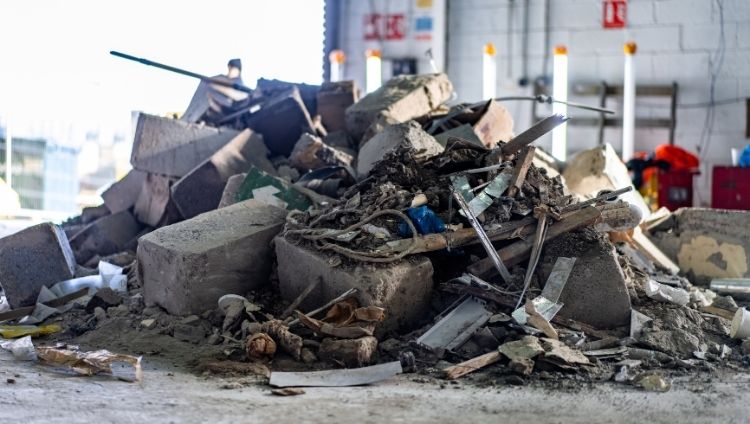Estimating the debris your project will produce and choosing the right garbage dumpster weight can feel overwhelming.
Keep in mind that different dumpster providers have varying weight limits, and the type of debris you’re dealing with will significantly affect how much can fit in each size.
This weight limit guide provides information on the typical weight limits for common dumpster sizes and the amount of debris that can be accommodated.
In this blog, we’ll discuss How much does a Garbage Dumpster Weight and What is the Dumpster Capacity. So keep reading this blog at the end.
Weight depends upon Dumpster Size.

10 Yard Dumpster
A standard weight limit for 10 cubic yard dumpsters is typically between 2-3 tons, or 4,000-6,000 pounds. To estimate how much debris can fit in a 10-yard container while staying within this average weight limit, consider the following:
- Carpeting: 2,500-3,500 square feet
- Concrete/Asphalt: 65-90 square feet of 10-inch thick concrete or asphalt
- Drywall: 1,600-2,250 square feet of 1/2-inch to 5/8-inch thick drywall
Related Post: How much does a 10 yard Dumpster Rental Cost?
20 Yard Dumpster
A 20 cubic yard dumpster usually has an average weight limit of 3-5 tons or 6,000-10,000 lbs. If you’re wondering how much debris can fit inside a 20-yard container while staying within the 3-to-5-ton weight limit.
- Carpeting:3,000-4,200 sq ft
- Concrete/Asphalt:80-110 sq ft of 10-in. thick concrete/asphalt
- Drywall:1,950-2,650 sq ft of 1/2-in. to 5/8-in. thick drywall
30 Yard Dumpster
The weight capacity of 30 cubic yard dumpsters is usually around 4 to 6 tons, equivalent to 8,000 to 12,000 pounds.
To estimate the amount of debris that can fit into a 30-yard container while staying within the average weight limit, you can refer to the table provided below.
- Carpeting:4,200-6,000 sq ft
- Concrete/Asphalt:110-155 sq ft of 10-in. thick concrete/asphalt
- Household Junk:475-680 sq ft of junk, like clothes, furniture, trash, etc.

40 Yard Dumpster
Typically, 40 cubic yard dumpsters have a weight limit averaging between 6 and 8 tons, which is equivalent to 12,000 to 16,000 pounds.
If you’re wondering about the amount of debris that can be accommodated in a 40-yard container while staying within the average weight limit of 6 to 8 tons, you can refer to the table provided below.
- Carpeting:7,200-9,600 sq ft
- Concrete/Asphalt:190-250 sq ft of 10-in. thick concrete/asphalt
Volume Capacity vs. Weight Limit
Volume Capacity
The capacity of a dumpster, or the amount of space it can hold, is measured in cubic yards, such as 10 cubic yards. Cubic yards indicate volume and not weight.
The weight of a 10-yard dumpster when filled can differ quite a bit based on what you’re throwing away.
For example, a cubic yard of mulch typically weighs around 1,000 pounds, while a cubic yard of concrete can weigh up to 4,000 pounds.

Dumpster’s weight limit
When scheduling a dumpster rental, we set a weight limit measured by tonnage, which is the boundary to keep your disposal costs low.
Landfills charge based on the weight of the disposed of material. A dumpster’s weight limit isn’t always determined by its volume. The type of material you’re disposing of plays a crucial role. For example, while two cubic yards of concrete might only fill 10% of a 20-yard dumpster, that same amount of concrete could significantly exceed the dumpster’s weight limit, potentially by over 100%. So, even if the dumpster looks like it has plenty of space, it could still be too heavy.
How is my Debris Weighed?
After your waste is loaded into the dumpster, the company will take it to the landfill. Upon arrival, the truck carrying the dumpster and waste will be weighed.
After the debris is unloaded, the truck is weighed again. The difference between the initial weight and the weight after unloading reveals the precise weight of the disposed waste.

Frequently Asked Questions:
How much weight is a 12-yard dumpster?
Usually, a container with a capacity of 12 yards can hold around 2 to 3 tons of garbage, which is equivalent to approximately 4,000 to 6,000 pounds of household trash, or about 20 couches weighing an average of 300 pounds each.
How do you calculate waste weight?
To determine the answer, you need to divide the original waste volume of 9,500 liters by the sample volume of 2 liters, resulting in 4,750 (9,500 ÷ 2).
To calculate the weight of the original waste using Method 2, we can follow these steps:
Divide the total volume of waste by the volume per unit: 9,500 L ÷ 2 L/unit = 4,750 units
Multiply the number of units by the weight per unit: 4,750 units × 3 kg/unit = 14,250 kg
How many tons fit in a dumpster?
A 30-yard dumpster container usually has a capacity of 3.5 to 5 tons, equivalent to 7,000 to 10,000 pounds.
These dumpsters are well-suited for medium-sized clean-up projects, light demolition waste, and entire room renovation.
How many tonnes of garbage are in a cubic meter?
The applicable conversion factor specified in the waste regulations for waste transported in cars or rubbish bags is 0.130 tonnes per cubic meter.
To determine the weight of the waste to be discarded, multiply the volume of the car trunk in cubic meters by the conversion factor of 0.130 tonnes/m3.
What is a unit of waste?
A waste management unit refers to the machinery, infrastructure, or tools used for conveying, storing, processing, or eliminating wastewater streams or byproducts.
Examples of waste management units include wastewater tanks, surface impoundments, private drainage systems, and biological wastewater treatment facilities.


